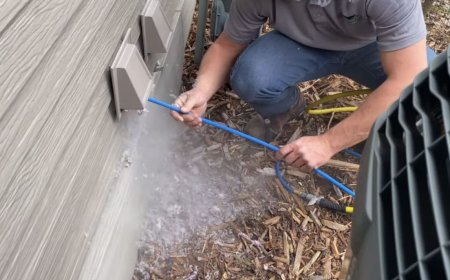How Emergency Procedures Save Lives During Electrical Incidents
Protect lives and property with clear electrical emergency procedures. Learn how OSHA Certificate training boosts workplace safety and crisis readiness.

Electricity is a silent partner in nearly every workplace powering equipment, lighting up spaces, and keeping operations running. Yet when something goes wrong, it can become a deadly hazard. Electrical incidents, including shocks, arc flashes, fires, or explosions, happen quickly and often without warning.
In workplaces where high-voltage machinery or live wires are present, even a minor error can be fatal. Thats why clear, practiced emergency procedures are not just helpful they are lifesaving.
Every worker should know what to do, who to call, and how to react in those critical first seconds. Proper planning combined with professional safety training such as earning an OSHA Certificate gives organizations the tools and confidence to respond effectively to electrical emergencies.
Understanding the Real Risk of Electrical Hazards
Electrical hazards are not always obvious. Unlike fires or chemical leaks, they often have no smell, no sound, and no visible warning until its too late. Common electrical incidents include:
-
Electric shocks from faulty tools or exposed wires
-
Burns caused by electrical arcs or short circuits
-
Fires ignited by overloaded circuits
-
Fatal electrocution during maintenance or wet conditions
A well-structured emergency response plan can drastically reduce the severity of these incidents. And organizations that train safety officers through programs like the OSHA Certificate ensure their teams are equipped to act fast and save lives.
Why Electrical Emergency Procedures Matter
When electricity is involved, there's no time to fumble through a manual or guess the next move. A fraction of a second can change a life forever. Emergency procedures help workplaces by:
-
Guiding employees on how to safely shut off power sources
-
Alerting medical or fire responders faster
-
Preventing panic and secondary injuries
-
Minimizing damage to property and equipment
-
Ensuring compliance with legal safety standards
The OSHA Certificate plays a vital role in this preparedness, providing safety professionals with the knowledge and leadership skills to handle real-life emergencies confidently.
The Link Between Training and Preparedness
To build a culture of safety, organizations must go beyond putting signs on the walls or holding once-a-year drills. Real preparedness comes from ongoing training, practical scenarios, and expert instruction.
Thats where OSHA training becomes valuable. The OSHA Certificate program equips participants with:
-
Risk assessment tools
-
Safe work practices around electrical equipment
-
Response protocols for fire and shock incidents
-
Knowledge of national safety regulations
-
Leadership skills to guide teams during emergencies
Employees who have gone through such training can spot hazards before they escalate and lead effective evacuations or shutdowns.
A Real-Life Example: The Forklift Incident
In a warehouse near Faisalabad, a forklift operator accidentally struck an exposed electrical panel, causing sparks and triggering a partial fire. A nearby supervisor trained in electrical safety and holding an OSHA Certificate sprang into action.
He immediately ordered a power shutdown, used the extinguisher rated for electrical fires, and directed the warehouse team to the emergency exit. Emergency services were called, and within 10 minutes, the fire was contained. No one was injured.
This scenario could have ended very differently without an emergency plan and a trained responder.
Step-by-Step: Emergency Procedures for Electrical Incidents
Heres a practical guide that can be adapted for most workplace settings:
Step 1: Dont Touch the Victim or Equipment
If someone is being shocked, never touch them directly. Use a non-conductive object (like a wooden broom) to break contact.
Step 2: Shut Down the Power
If safe to do so, cut off the power supply from the main breaker.
Step 3: Raise the Alarm
Use designated alerts, radios, or emergency phones to inform your internal safety team.
Step 4: Administer First Aid
Only when the power is off, check the persons breathing and pulse. Begin CPR if necessary.
Step 5: Call Emergency Services
Even if the victim seems okay, internal injuries are common. Always call an ambulance.
Step 6: Secure the Area
Prevent others from approaching the area until its declared safe.
Step 7: Document the Incident
Record the time, actions taken, and response time. Review procedures for improvement.
Key Elements of a Strong Emergency Plan
A good emergency plan goes beyond words. It needs to be practical, specific, and drilled regularly. Heres what every workplace should include:
-
Risk assessments for areas with electrical exposure
-
Clearly marked shutoff points and whos authorized to access them
-
Emergency contact numbers posted in every section
-
Insulated tools and PPE for trained staff
-
Regular training sessions and practical evacuation drills
-
Documentation and review after every incident or near-miss
Many of these practices are directly covered in the OSHA Certificate training modules, making the course a valuable asset for any organization dealing with electrical risks.
Dont Wait Until Its Too Late
Emergency plans are like insurance you hope you never need them, but if the time comes, theyre priceless. Electrical incidents escalate quickly, and without training, they often result in serious injury, death, or costly property loss.
Businesses that take safety seriously invest in real-world preparation.
Thinking about strengthening your teams safety knowledge? Explore the OSHA Course in Pakistan and take the first step toward a safer, more prepared workplace.
Common Mistakes That Can Be Fatal
Despite their best intentions, many organizations make critical errors like:
-
Not clearly labeling electrical shutoff points
-
Relying on untrained staff to perform emergency actions
-
Forgetting to update procedures as equipment changes
-
Using incorrect fire extinguishers on electrical fires
-
Skipping drills because its just a formality
Avoiding these mistakes doesnt cost much but not avoiding them might cost everything.
Final Thoughts
Every workplace that uses electricity (and thats basically every workplace) is at risk of electrical incidents. But the risk doesnt have to be deadly. By implementing well-structured emergency procedures and ensuring your safety staff is trained through a program like the OSHA Certificate, you put your people and your business in the best possible position to handle any crisis.







































